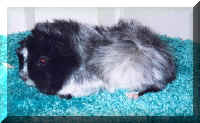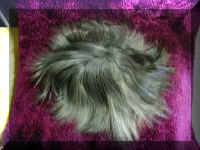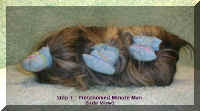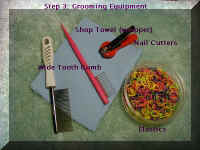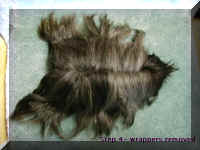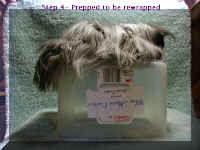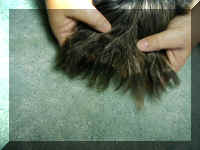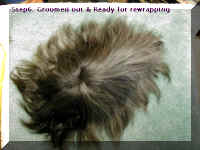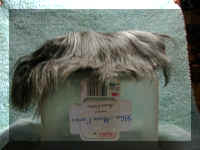
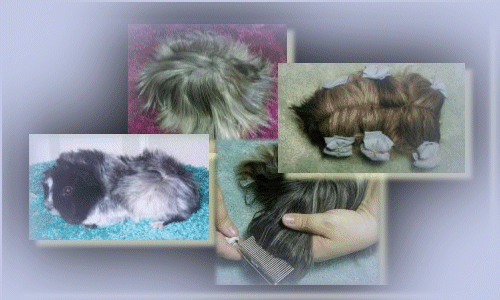
am often asked by people just getting into long hair cavies "How do you get them to grow long hair?" Ahh, if only I had a simple answer.
I suppose the place to start is at the beginning. Here is a picture of my 2000 ARBA National Convention Best of Breed winning Peruvian Satin boar CozyCavies Minute Man at age 3 weeks.
The very first thing you need to
coat out a winning long hair is a well bred animal.
Do your research and look at various animals before you decide on a prospect for showing. You will be spending a lot of time with your show animals so it is worth the effort to find the best that you can. Look for a nice strong body, broad shoulders and nice head. The coat can be difficult to evaluate on a small baby so it is important to work with a breeder that can help you evaluate the potential.
However, babies go through many changes so don't expect to be able to pick a guaranteed BIS winning animal at 3 weeks.
Do your research and look at various animals before you decide on a prospect for showing. You will be spending a lot of time with your show animals so it is worth the effort to find the best that you can. Look for a nice strong body, broad shoulders and nice head. The coat can be difficult to evaluate on a small baby so it is important to work with a breeder that can help you evaluate the potential.
However, babies go through many changes so don't expect to be able to pick a guaranteed BIS winning animal at 3 weeks.
Tracy of CozyCavies (Now Fort
York ) has been working diligently on peruvian satins for six years and
was kind enough to allow this stunning little fellow to come live with me
in Cincinnati. So - how do you get from a young junior to a senior
in full coat as seen here with his Best of Breed ARBA trophy and also in a
top view. Minute Man is nine months old here.
Minute Man is ready to start the
grooming process. These pictures are fresh out of his cage from
his last grooming two days ago.
Before you actually start wrapping
you will need to get your grooming equipment ready. This is what
I use but grooming is very individual. There is no one right or
wrong way to groom but this works for me.
You will need to have a comb with
medium teeth and perhaps a brush. I don't routinely use brushes
but many people do - again it is personal preference. I use shop
towels from the hardware store for my wraps. They are a heavy
weight paper towel. People use a wide variety of wrapping
materials ranging from paper towels to wax paper to cloth squares.
I have tried them all and the shop towels are my personal favorite.
You will also need rubberbands. I prefer the small ones. I
buy mine at the beauty supply store but the ones for horse manes and
tails work well also. Nail clippers are a necessity as long
nails will alter your animals stance on the board and give him a
sloppy topline.
The wraps have just been removed
from Minute Man's coat. I often use a grooming aid on young
animals shown in the side view. When animals are first being
taught to stand still for grooming it can be helpful to place them
on an elevated platform that is just big enough for them to stand on
- in this case an inverted Tupperware type container. It tends
to help keep the animal stationary which is especially helpful when
you are first learning to wrap - a quiet cavy is much easier to work
with.
It is important when grooming to
avoid needless loss of hair. Every strand of hair adds to
density and a pulled out strand takes months to recover so be easy
when grooming. If you get in the habit of grooming your
animals at least every third day - I prefer every other day - you
will lose much less hair. Knots and matts can form quickly
and although they can often be removed it takes patience on both
your and the cavies part to accomplish. Prevention is
definitely the better way to go.
The first thing I do after
removing the wraps is to finger groom the cavy. this is done
by gently going through the coat and feeling for small tangles.
If any are found they are carefully separated with the fingers.
Persistent tangles may require the use of a detangler, waterless
shampoo or the like. These may be used between baths but
must be removed from the coat prior to showing.
After finger brushing the coat
I go over the coat with my medium tooth steel comb being sure
the coat is free of tangles and lies smoothly.
This is the point in grooming
where I decide if a bath is required. Generally I bath my
animals every three to four weeks. However, if I notice
that an animal's hair is starting to get a sticky or tacky feel
during combing I know that a bath is in order. Boars often
get a gummy deposit in the rear section. This can be spot
washed as the waxy substance can quickly cause big knots in the
rear sweep if not addressed.
This is also the point in time
when I check my animals for any external parasites or signs of
coat breakage. Show animals are constantly exposed to lice
and mites at shows and every breeder/exhibitor needs to have
some sort of program in place to deal with the pesky things.
I use several different things depending on the situation.
the most important thing though is to check for them.
Remember it is no disgrace to find a louse or evidence of mites
but it is a disgrace to just leave them there and spread them
around. They are fairly easy to eradicate.
This is also a good time to
check if any nails need to be trimmed and to check ears, eyes
and teeth for any problems. General body condition should
be looked at as well and either excessive weight or underweight
should be evaluated. Animals should be weighed at least
once a month and before each show to ensure they are in the
appropriate class.
Page 2 : The
Wrapping Process Click Here
(We placed the next section
of the wrapping process on another page to help with quicker loading time)
